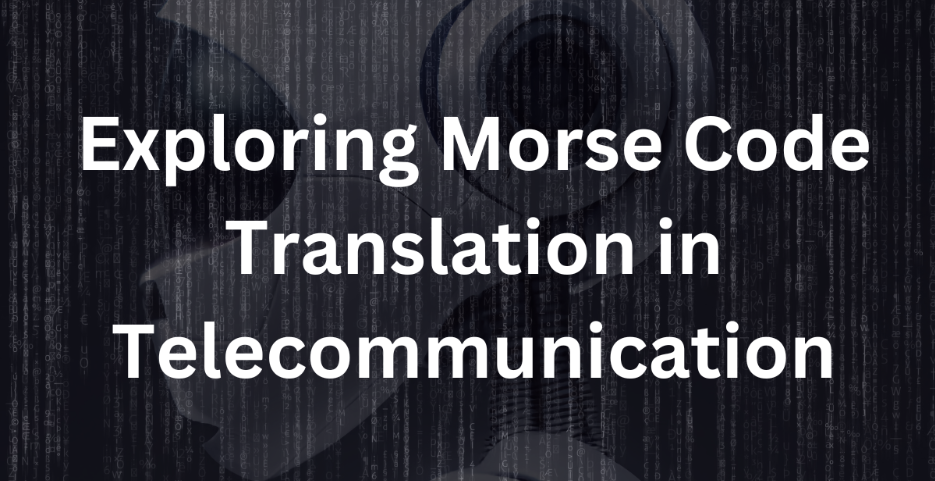Morse code is a process by which texts are translated into strings of shortened and long sounds termed dots and dahs respectively. The name of such an early system developed for electrical telegraphy was Samuel Morse’s code. Today, Morse code continues to be utilized in different ways, such as during amateur radio, aviation, and even astronaut communications.
This paper is going to discuss the origination of the Morse code and the role that plays in communication systems, as well as how it has advanced.
We shall also look at different uses of Morse in contemporary-day communications and the impact on other communication technologies.
Therefore, let us venture into the realm of Morse code and see how this technology has changed the manner in which people exchange messages.
Morse Code Basics

Explanation of Morse Code
In the center, Morse code is a binary communication system which combines dots and dashes to represent letters, numbers and markers. A different pattern that can be identified by trained operators with ease is formed using unique sequences of dots and dashes for each character.
How Morse Code Works
Morse code is transmitted using electrical pulses, audio tones, and visual signs. Dots and dashes were represented by electric pulses in early telegraph systems that moved across wires. The Morse code had been used for transmissions of simple audio tones whose durations were different. Today’s Morse code transmission commonly incorporates visual cues like blinking lights and moving shapes.
Morse Code Chart
The Morse code chart is a reference book of codes. It shows the corresponding dot-dash pattern for every letter, number or punctuation symbol giving the opportunity to translate one way or another.
Applications of Morse Code
Aviation, space exploration, and Morse code.
Even though there has been a shift from analogue to more advanced digital communication, Morse code still remains relevant within aviation and astronautics. Spacecraft or aircraft emergency beacons frequently send SOS in Morse code, so they are picked up regardless of any lost radio transmission.
Morse Code in Amateur Radio
For the longest time, amateur radio lovers, called “hams” by their peers, have communicated in morse as a way of giving themselves a challenge to communicate with fellows across the globe. The Morse code communication tool contests as well as other unique functions help form new friendships and ensure the survival of this once-popular method.
In modern-day communication systems.
Although Morse code currently competes with contemporary technology, it remains useful for particular purposes. For example, Morse code acts as a contingency method of communication in remote regions with poor or lack of digital infrastructure and allows vital alerts to pass through.
Morse Code Translators
Overview of Morse Code Translators
This is a type of digital software or an online tool called a Morse code translator that helps to translate text messages from Morse code into ordinary language. Users are able to encode as well as decode their messages in a simple way without having to know Morse code.
Types of Morse Code Translators
A variety of translator Morse code includes ordinary text-based programs and more advanced applications that support audio and real-time translation. Users’ needs and levels determine their selection of translators of proficiency with Morse code.
A Guide to Using a Morse Code Translator
Normally, employing a Morse code translator is simple. It translates inputted text written in plain language to Morse code, or vice versa. Certain translators provide other options like selecting the Morse code variant (International Morse Code or American Morse Code), modifying the text speed, and hearing how the sound of the Morse code will be played.
Pros and Cons of Morse code
Advantages of Morse Code
- Resiliency: Morse code is also workable in difficult circumstances like bad radio reception and short wavelength making it appropriate for distress communication.
- Efficiency: It should be noted that Morse code provides a quick and efficient means of transmitting information in scenarios characterized by limited bandwidth.
- International Standard: The international sign language popularly known as Morse code cuts out the barrier of distinct languages and enables people to communicate.
- Ease of Learning: It is possible to master text to Morse code in a short space of time because of its simplicity.
Disadvantages of Morse Code
- Learning Curve: Although it is relatively simple, Morse code has to be practiced and learned properly.
- Susceptibility to Human Error: Misinterpretation can occur when a person manually encodes or decodes Morse code.
- Limited Bandwidth: However, Morse code requires longer transmission times than the current digital communication means when conveying information in huge volumes.
- Obsolete in Everyday Communication: Many of these new communication technologies have left Morse code encoders behind as a tool used in everyday communication.
Comparison of Morse Code with Other Communication Technologies
| Feature | Morse Code | Modern Communication Technologies |
| Resiliency | Highly resilient, operable under adverse conditions | Less resilient, susceptible to network disruptions |
| Efficiency | Efficient for conveying short messages, less efficient for large data transfers | Highly efficient for transmitting large amounts of data |
| International Standard | Universally recognized language | Diverse protocols and standards, requiring compatibility considerations |
| Ease of Use | Requires practice and dedication to master | Generally easier to use, with intuitive interfaces and user-friendly features |
| Applications | Specialized applications, emergency communication, amateur radio | Widespread use in everyday communication, including personal and professional settings |
Conclusion
Although Morse code might be old, it remains one of the most important advances that have ever taken place when it comes to the exchange of information over long distances. It worked efficiently on difficult terrains and overcame a host of obstacles thanks to its resilience, which ensured it remained relevant for a long time and communicated even across language barriers.
Although it is not as popular as other modern communication technologies. Morse code exists and serves in specific fields as a reminder that human intelligence is timeless.
